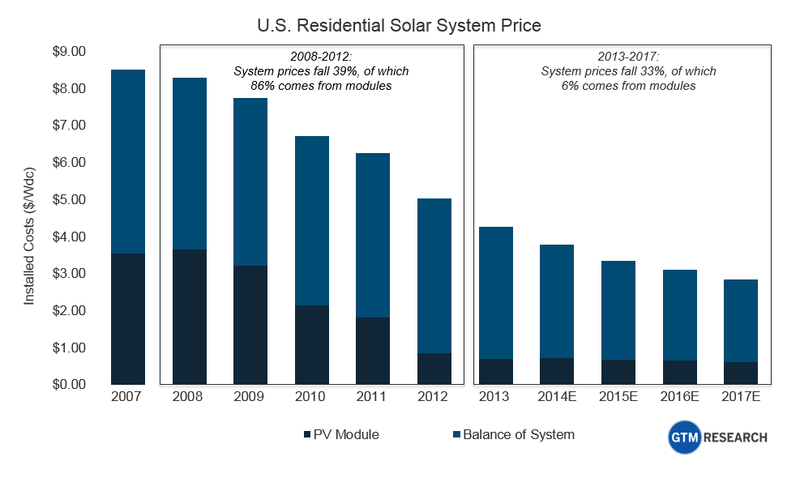The price of residential solar power in the United States keeps dropping. Back in 2008, the cost of installing a rooftop solar system was about $8 per watt. Today, it’s about half that — and still falling.
Up until 2012, that price decline was largely due to the fact that the photovoltaic panels themselves were getting cheaper, driven by a glut of Chinese manufacturing and various technology improvements. This story got a lot of attention in the press.
But things have changed a lot this past year. Yes, solar modules are still getting cheaper, but the decline is now much more gradual (particularly now that there’s no longer a glut of manufacturing). Instead, as this chart from GTM Research shows, the major innovations nowadays are in “balance of systems” costs — incremental improvements in design, engineering, labor, and financing for rooftop solar systems:
Between 2008 and 2012, the cost of installing solar power fell 39 percent — and 86 percent of that cost was due to the drop in photovoltaic module prices. But now things are changing: GTM expects the cost of installing solar power to fall 33 percent between 2013 and 2017 — but only 6 percent of that will come from a drop in module prices.
So, even though solar power still generates just 0.4 percent of America’s electricity, it’s expected to keep growing rapidly in the years ahead. (In 2013, the price of generating electricity from rooftop solar was around 30 cents per kilowatt hour on average. That’s higher than the national retail average of around 12 cents per kilowatt hour — but that’s just the average. In some select regions, solar is creeping closer to parity.)
In an interview, GTM Senior Vice President Shayle Kann explained what’s going on here. After 2007, the cost of photovoltaic modules fell dramatically — partly because of improvements in technology, partly because the price of polysilicon came down, and partly because there was a glut of manufacturing (particularly in China) that drove prices down.
That oversupply has largely resolved itself. Instead, the big innovations nowadays are coming in “balance of systems” costs — all the little steps along the way that are required to take a photovoltaic panel from the factory and put it on your roof, generating electricity. In particular, there have been a couple big changes here:
1) Solar modules are getting more efficient. “This doesn’t necessarily make the modules themselves cheaper,” Kann says. “But as modules get more efficient, you can get the same amount of power in a smaller area of your roof, which makes it easier to install, you need less racking and wiring, and it saves money on balance-of-systems costs.”
2) System manufacturers are facing pressure to cut costs. Again, back in 2008 to 2012, panel manufacturers faced a lot of competition and pressure to cut costs. Nowadays, that same pressure applies to the people making other parts of solar systems — the racking, for instance.
3) Economies of scale. Historically, the residential solar market consisted of thousands of small local installers who had high costs for finding new customers. But nowadays, the rooftop solar industry is dominated by some large companies — particularly SolarCity and Vivint, who had half the rooftop market in the second quarter of 2014. “So as the big guys gain more scale,” Kann says, “you see some savings out of that.”
Will solar power keep getting cheaper?
GTM currently projects the price of installed solar to drop to around $3 per watt, on average, by 2017. Kann says that he expects the price of solar to continue to drop as solar installers find ways to eke out little savings here and there — decreasing those balance of systems costs.
Right now, for instance, it’s still quite expensive for solar companies to find and sign up new customers. But as the solar market grows, word of mouth spreads, and referrals grow, that actually becomes easier — this is known as “neighborhood network effects.” In other words, solar is contagious. People are more likely to sign up for solar power if they see their neighbors put a system up.
One big wild card, meanwhile, is what happens if Congress allows the federal tax credit for rooftop solar systems to expire at the end of 2016. At that point, the credit will drop from 30 percent to 10 percent for third-party installers (i.e., when SolarCity lets you lease a rooftop solar system for no upfront cost) and expire entirely for residential owners.
If that happens, Kann says, the solar market probably won’t get wiped out entirely — especially since solar costs are dropping and rooftop systems are starting to make sense in states that are sunny and have high electricity costs (like California, which currently accounts for half the market). But the expiration of the federal tax credit may stop solar installers from expanding into new markets.
And the expiration of the tax credit is likely to have the biggest effect on utility-scale solar — that is, the large solar power plants that some electric utilities are now building. Those plants have to compete more directly with things like natural gas, so they’re more sensitive to changes in policy.
Article Reference:
This article originally appeared on VOX edited and Updated by Brad Plumer on October 16, 2014.












Comments